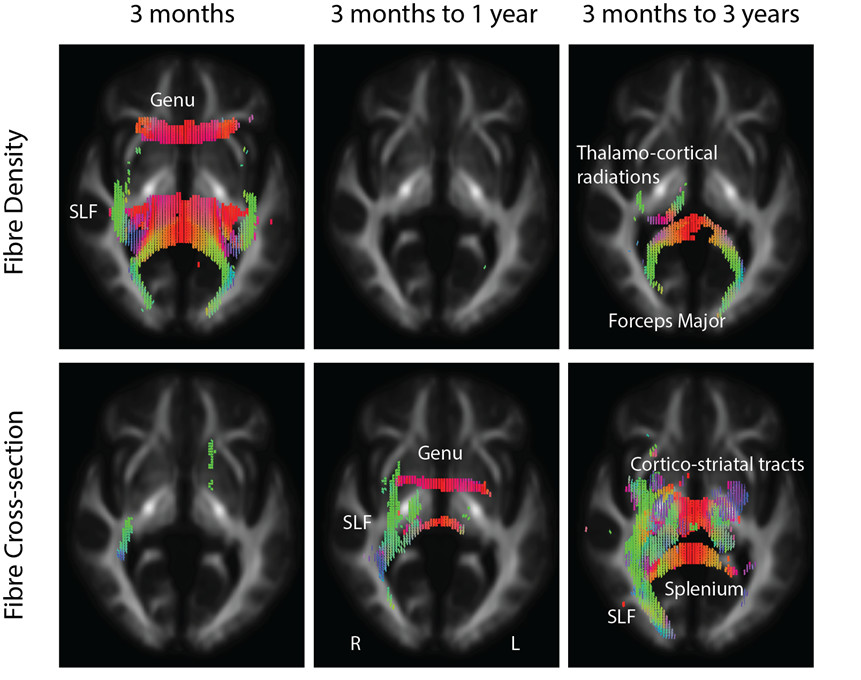
Health & Medicine
Q&A: How immune cells could help diabetes and stroke

The loss of brain white matter and associated cognitive decline is faster for at least three years after a stroke
Published 16 March 2023
Our brains are like a computer –made up of processors and connections.
In the brain, these two functions happen in our grey and white matter, respectively. Grey matter contains the processors, while white matter has the high speed cables that provide the communication between different parts of the brain.

White matter is made of high-density bundles of fibres. The fast transfer of information between different brain regions is important, and that’s why white matter integrity is essential for supporting our ability to think – our cognition.
Anything that disrupts this information transfer – for example, a stroke – is likely to impact our cognitive abilities.

Health & Medicine
Q&A: How immune cells could help diabetes and stroke
We tend to think of stroke as an acute injury. It happens suddenly and then there is a process of recovery. That’s dependent on the severity of the stroke, the speed of intervention and the quality of post-stroke care.
But our research shows that strokes can also lead to ongoing changes to the brain that can continue for years.
The most common kind of stroke is an ischaemic stroke. This occurs when a blood clot blocks or narrows an artery leading to the brain, reducing or completely blocking the blood supply to a particular brain area. This causes an injury around the clot as crucial oxygen and nutrients are not delivered.
When strokes occur anywhere in the brain, they also disrupt communication between the injured area and the rest of the brain, including both grey and white matter.
Typically, white matter volume gradually increases in the first 40 years of life, peaks at around 50 years of age, and then slowly decreases from 60 years of age onwards.

In healthy aging brains, a variety of changes to the structure of brain white matter have been observed, including reduced volume, lesions and disrupted integrity. Loss in white matter volume and increased number of white matter lesions may be responsible for functional decline – like worsening cognition as we age.
Our research team, from the University of Melbourne, the Florey Institute, Austin Health and Monash University conducted the Cognition and Neocortical Volume After Stroke (CANVAS) Study, which followed patients for three years after their strokes and compared their brain structure and their cognition to those of a control group of similar age who did not have a stroke.

Health & Medicine
Mapping the terra incognita of our brains
We first observed a widespread decline in the health of white matter at three months after a stroke compared to the control group.
Our team, led by Professor Amy Brodtmann, also found that worse cognition was associated with lower grey matter volume and this continued to impact cognition as late as three years after stroke.
In our most recent paper, published in the journal Neurology, we looked at 71 of the patients with ischemic stroke and 36 stroke-free, age and sex-matched control participants. All of our participants underwent magnetic resonance imaging (MRI) brain scans and a series of cognitive tests to measure their ability to think, including elements like attention, memory and language.
These scans and tests were repeated at three, 12 and 36 months to follow the trajectory of brain health and cognition post-stroke.

We found that after a stroke, white matter declined faster than in the regular population, for the full three years, in areas that are important for thinking.
We used a new method of white matter imaging, called fixel-based analysis, which allows us to tell if the decline involves a reduced number of fibres in a particular white matter bundle, what we term ‘fibre density’ change, or a shrinking of the bundle that reduces the diameter of the bundle, called ‘fibre cross-section’ change.

Health & Medicine
Space for re-learning after a stroke
Our research found that both changes were present, and often the loss of fibre density in a particular tract was followed by a reduction in fibre cross-section.
In other words, the bundle starts to shrink once the density is lower.
It is somewhat surprising to find that the brain continues to experience these detrimental consequences of stroke three years after the event.
But actually, several previous studies have showed that stroke survivors are more likely to experience cognitive impairment and dementia, compared to those people who did not have a stroke.
So, it’s hugely important to recognise that after a stroke, we recognise that our brains are vulnerable to further disease and we introduce preventative measures to counter this decline in brain health.

We know that structural changes in the brain occur before changes in cognition, so it’s never too late to make changes to slow down any subsequent loss of cognition.
Introducing a healthy lifestyle, diet, sleep and as little as 30 minutes of exercise per day can improve brain health and help slow down cognitive impairment after a stroke.
This study was supported by a National Health and Medical Research Council project grant, the Brain Foundation, Wicking Trust, Collie Trust, the Sidney and Fiona Myer Family Foundation, and the Australian Research Council.
Banner: Envato Elements